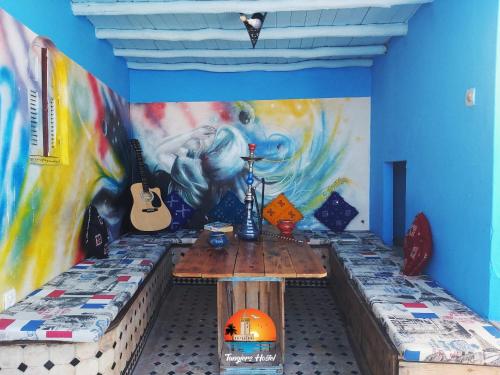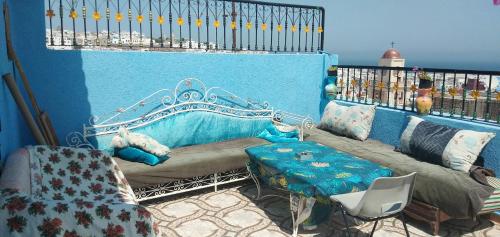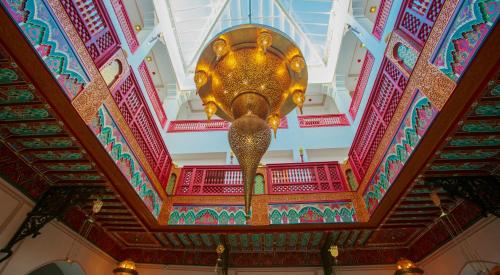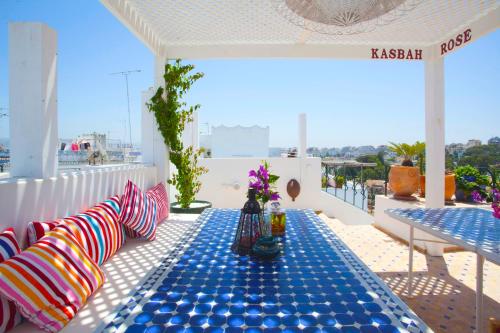Looking up a hill, I wonder if this could be the one I’m looking for. Is there a crystal shop at the top? Somewhere here in the Moroccan city of Tangier, I’m hoping to find one.
Not that I actually want to buy any crystal, mind you. And not that I expect that the one I seek actually exists. But, in my head, this is the association I have with Tangier.
Somewhere at the top of a hill is a crystal shop with an old man who has given up on his dreams, waiting out his days with a resignation void of inspiration.
It’s this reference to Paulo Coelho’s novel, The Alchemist, that I think of as I walk through the old medina of the city.
In case you haven’t read the book yourself, Tangier is where the protagonist, Santiago, arrives from Spain on his way to the Egyptian pyramids on the search for his personal legend. He, however, gets waylaid in Tangier after he is robbed and spends a year working for the man at the crystal shop.
Like most of the places and characters in The Alchemist, Tangier and the shop’s owner represent something deeper. They are symbolic of a melancholic routine that does not look for emotional innovation and does not seek the potential within.
Santiago helps the shop grow and gives its owner the means to follow his passion in life.
Paulo Coelho’s depiction is perhaps unfair in reality, although it serves its allegorical purpose. Tangier is, in fact, a bustling city where the constant ferries bring European influences to the entrance of North Africa.
Spanish and French mix with the sounds of Arabic and English. Everywhere people are coming and going, the distant sight of the Spanish coast on the other side of the water a comfort for some, a hope for others.
Paulo Coelho was not the first writer to find inspiration with Tangier. This dynamic blend of cultures in an environment of exoticism brought many Americans to the city in the 1940s and 1950s. People like Paul Bowles, William Burroughs, Truman Capote, Tennessee Williams, and Jack Kerouac.
William Burroughs is said to have liked it here because of “the hashish and the boys”. For many of the others, it was more about having a familiar community of expatriates in an unfamiliar world.
This was the age of the Beat writers and the genre flourished in this Western pocket of Africa.
One afternoon I take a seat at the Central Cafe in a small square in the heart of Tangier’s medina. A middle-aged waiter with a waistcoat comes to take my order.
He does not look particularly Moroccan but nor does he look like any other particular nationality. He, like the city, is international.
I, terrible at languages and confused by this situation, order a long black in a mixture of about three tongues: “Could I please have a cafe noir grande, por favor, merci.”
It’s at this cafe that the American writers of the Beat era would often converge.
Back then, half a century ago, I can imagine it being a slightly more chaotic and authentic experience, loud conversations fighting with a haze of smoke for control of the space beneath the awning.
Now it’s popular with tourists – not because it is much different from all the other cafes in the medina but just because its location on a main central path makes it a natural place to stop for a rest.
“Do you want some smoke, some hashish?” a man sitting next to me asks.
I shake my head and smile and think that maybe things haven’t changed too much since the days of William Burroughs… except that it’s quite likely this is some kind of set up or scam.
All over Tangier, I’m constantly being offered hashish. There is nothing exotic or hippy about it, though. It just feels dodgy and annoying.
Outside of the old medina, a large and rather modern city has grown. Along the promenade of the main beach, nightclubs and large restaurants proudly proclaim their European influences – in other words, you can drink alcohol here.
In the centre of the city, there are large clean boulevards with busy shops and cafes. This is not the Tangier that I had expected and it’s certainly not the one the writers moved through half a century ago.
I’m not going to find my crystal shop at the beach or in the city centre anyway. I’m actually coming to the realisation that I’m not going to find it anywhere. And that is probably a good thing.
Santiago found his in The Alchemist because he needed to – he was on a quest to realise his personal legend and this was a step along the way. I am not on such a quest at the moment and Tangier is not the city to me that it was to him.
But that doesn’t mean there aren’t lots of things to do in Tangier, and it’s worthy of a day or two when you’re travelling in Morocco or visiting on a cruise.
Medina
An unmissable spot to visit in every Moroccan city is the medina. Tangier’s old town (or medina) is surrounded by fortified walls crisscrossed by a maze of pedestrian-only alleyways that you can stroll to discover the town’s markets (souks), museums, cafes, mosques, and traditional riads.
Petit Socco
Once Morocco’s most important marketplace, the Petit Socco is a great spot to visit for a local experience.
The pedestrian square used to be the hub of European diplomats and bankers back in the twentieth century. It also has a legendary appeal because it was where writers and artists such as William S Burroughs and Camille Saint-Saëns used to sit for inspiration.
Today, the Petit Socco is among the locals’ favourite hang-out spots, thanks to the many buzzing cafes, restaurants, and hotels. Grab a mint tea at one of the cafes and enjoy some people-watching.
Grand Mosque
During your time in the Tangier Medina, make sure to stop at the Grand Mosque. Built in the early 1800s in the place of a demolished Portuguese church, the Grand Mosque is a beautiful sight, with its prominent minaret piercing the town’s skyline, ornately decorated with distinctive white and green tiles.
Inside is a prayer hall and a courtyard with a fountain for ritual ablutions, but going past the decorated gates isn’t allowed unless you are Muslim. However, the Grand Mosque is worth a look even just from the outside.
American Legation
An interesting museum in the very south of Medina, the American Legation speaks volumes about Morocco – United States relations. Morocco was, in fact, the first country to recognise the US as an independent country in 1776.
The five-storey, Moorish-style building was used for diplomatic purposes in the past and it is listed in the US National Register of Historic Places.
Inside the American Legation Museum, you can visit well-curated exhibits displaying a wide array of documents, photographs, and paintings chronicling the relationship between the two countries. A must-see in the museum is James McBey’s painting Zohra, often referred to as the ‘Moroccan Mona Lisa’.
The American Legation is open:
Monday to Friday from 10:00 – 17:00
Saturday and Sunday from 10:00 – 15:00
It is closed on Moroccan holidays.
A standard ticket is 50 MAD (US$5).
Kasbah
Inside the Tangier Medina, make sure to walk the Kasbah, the section at its northern end. Still inhabited by the locals, many of the riads in the Kasbah have been turned into boutique hotels. The area features several interesting museums and historic cafes where you can soak up an authentic atmosphere.
Kasbah Museum
The Kasbah Museum is the perfect place to learn about Tangier’s past. The most popular museum in town, it showcases many historical relics of Moroccan craft, ranging from pre-historic Tangier to bronzes from Roman-era cities, and Tangier’s English period in the 17th century.
Right beside the Kasbah Museum, housed in the former Sultan’s Palace, is the Contemporary Art Museum. Hosted in the old-restored Kasbah prison, this museum was opened in 2021 and pays tribute to local artists from Morocco’s northern region.
The best part? You can visit both museums with the same ticket.
The Kasbah Museum is open Wednesday to Sunday from 10:00 – 18:00.
It is closed on Mondays and Tuesdays.
A standard ticket is 30 MAD (US$3).
Ibn Battuta Museum
This museum is entirely dedicated to the great explorer Ibn Battuta, who travelled extensively through Africa, the Middle East, Europe, and Asia in the early 14th century.
Born in Tangier in 1304, Ibn Battuta’s travels exceed the ones of the more famous Marco Polo. The museum pays tribute to his life and journeys via interactive exhibits, with translations in Arabic, French, and English.
Step inside the museum and get ready to be mesmerised by Ibn Battuta’s astonishing life and important role in Morocco’s cultural heritage.
Coast
Facing the Straits of Gibraltar, Tangier’s coastline is dotted with spectacular beaches. There are areas of the coastline that are busier, with cafes and restaurants where you can have a break and take in stunning vistas.
By visiting Tangier’s coast, you will also enjoy a long seaside promenade and an archaeological site.
Phoenician Tombs
Step just outside the Kasbah to visit the centuries-old Phoenician Tombs. Carved into the hillside overlooking the Strait of Gibraltar, this open-air necropolis is where to discover Tangier’s early beginnings.
Many of the Phoenician Tombs have been carved directly into the rocks, and the many Roman artefacts and tools retrieved from their inside are on display in the Kasbah Museum.
The tombs are so close to the sea that they are often filled with water (and litter), making it impossible to visit from the inside. However, the location offers breathtaking views over the town and the port.
Café Hafa
Opened in 1921, the historic Café Hafa hasn’t changed a bit ever since. There isn’t a better place in town to sip on Moroccan mint tea and admire the gorgeous panorama of the Mediterranean Sea.
Its reputation for hosting celebrities like the Beatles and the Rolling Stones helped make Café Hafa one of the most frequented spots in town, so it may be busy when you visit.
If you don’t want to face the crowds, there are other options in Tangier, which is considered one the best cities in Morocco to experience the cafe culture, which started in the 1960s with the many expat artists flooding into town.
Café Hafa is open every day from 9:00 – 23:00.
Corniche
The Corniche is a stunning promenade that has become one of the most popular things to do in Tangier. Built as a part of a major urban planning project, the Corniche now bends around the entire Bay of Tangier.
Running from the new tourist port and Villa Harris, a nineteenth-century estate now housing a contemporary art museum, the Corniche is a spectacular spot to relax. Lined with restaurants and cafes, this promenade features tall palm trees and two beaches – Plage Municipale and Plage Malabata.
The views from the Corniche are breathtaking, with Cap Malabata across the bay and the outline of the Spanish town of Tarifa in the distance.
Beaches
There are several beaches in and around Tangier that you can visit for sunbathing, a swim, or even something like kayaking or jetskiing.
The main municipal beach, called Tangier Beach, is hugged by the Corniche, and it’s the easiest one to get to. Boasting a long stretch of golden sand, it doesn’t have the best-quality waters, but it’s perfect for a day of lounging.
If you fancy a good swim, get outside the town, where you will find plenty of beaches, some awarded with the Blue Flag. Head to Merkala Beach, also called ‘Casino Beach’ for its proximity to the Tangier Casino Hotel, for some snorkelling, or to Playa de la Alcazaba for leisurely swims.
Modern city
Tangier is one of Morocco’s most modern cities. Its rapid development and modernisation started in the early 2000s when King Mohammed VI prioritised the development of northern Morocco.
A new-looking souk and seaside promenade, and exciting additions such as the business district and a new football stadium, make Tangier’s modern city a must-see.
Grand Socco
A top thing to do while in Morocco is visit the souks, the traditional marketplaces usually located in the medina. In Tangier, this is called the Grand Socco, with plenty of stalls and shops where you will find everything from food to handmade crafts.
Compared to other Moroccan cities, the souk in Tangier has a pretty modern look since it’s a paved square with a big central fountain lined with palm trees.
On one side of the Grand Socco is the popular Cinema Riff, an old cinema in Art Deco style that screens mainstream and independent films. This iconic venue is also a cafe, which is a nice spot for a bit of a breather.
St Andrew’s Church
Among the oldest Anglican churches in North Africa, St Andrew’s Church is located just a couple of minutes on foot from the Grand Socco.
The first church was built in 1880 when Sultan Hassan I granted Tangier’s British community permission to build a church in town. However, this first church was too small for the congregation, so the current St Andrew’s Church was erected in place of the old one in 1905.
Designed in the Moorish style, St Andrew’s Church also has a cemetery where you find the gravestones of curious figures and travellers, like a legendary local bar owner known only as Dean.
The church also displays other interesting sights, such as a copy of the Lord’s Prayer written in Arabic above the main altar.
St Andrew’s Church is open Monday to Sunday from 10:00 – 13:00 and 15:00 – 17:00 except Fridays.
Admission is free.
Tours
Tangier isn’t a big city, but there’s a lot to discover in its dense maze of streets. Rather than just wander – and potentially miss things – I think a great idea is to join a tour and rely on expert local guides to show you around from all its angles.
City tour
When looking for tours of the vibrant Tangier, I would recommend one that gives you a well-rounded panorama of its history and cultural heritage.
Tangier has long served as a gateway between Africa and Europe, and its rich culture can be seen in the historic streets of Medina and its many other iconic landmarks with diverse architectural styles.
A fantastic option is this half-day guided city tour, during which you will stroll through the winding alleys of the old town, experiencing the smells, tastes, and sounds of the souks. This tour will also take you outside Tangier, all the way to the fabulous Cape Spartel.
There are a few other good alternatives to consider here:
Another option is this tour of Tangier, which includes the visit to the Caves of Hercules.
Food tour
Once you get to know Moroccan food, you’ll love it. Tagine, harira, and couscous are all a delight for the palate.
Because of the international influences, the cuisine in Tangier is particularly interesting and there’s lots to discover.
To savour Tangier’s flavours in the best way, join a food tour with a local expert who will disclose to you all the secrets of Moroccan cuisine. I would recommend this top food walking tour combines an informative stroll through Tangier’s old streets with the tasting of snacks and local products.
In fact, there are a few other fun food tours here:
Another option is not just to eat the local food – but also learn how to make it! If that tickles your taste buds, there’s this excellent cooking experience that also includes a trip to the local market.
Day trips
There are fantastic things to see in Tangier’s surroundings. So why don’t you take one (or more) day trips to see what’s out there?
From natural wonders to unique cities with unmatched vibes, hop on a car or take the train and get ready to find yourself in a completely new environment.
Cape Spartel
The northwesternmost point of Africa, Cape Spartel is 300 metres above sea level, and it’s a great spot for marvelling at views over the Strait of Gibraltar.
The waters underneath the promontory have been the theatre of several naval battles throughout history which you can learn more about by visiting the small museum hosted inside Cape Spartel lighthouse.
From the lighthouse, you can reach the popular Cave of Hercules. This cave, part natural and part man-made, was inhabited by local Berber tribes and it’s linked to Greek mythology. Step inside the cave to see Berber drawings and writings and admire its entrance, shaped like Africa.
While it’s possible to visit Cape Spartel independently, it’ll be much easier with this guided day tour that also includes some of the main sights in town.
Tetouan
A bit further afield, the historic town of Tetouan is in easy reach of Tangier and makes for an excellent day trip to see a more local slice of traditional life.
Tetouan is located on the northern coast of Morocco and was of key importance for the relationship with Andalusia from as early as the 8th century. The influences of this contact with Spain can be seen in some of the design and art here.
Built on the slope of a hill, the city’s medina has been designated as a World Heritage Site, even though it’s one of the country’s smallest. It’s within these walls, where little has changed over the centuries, that you’ll find some of the best things to do in Tetouan.
I would probably recommend taking a tour so you can see some of the region’s other highlights at the same time – for instance, there’s this excellent day tour that also includes the blue city of Chefchaouen.
Chefchaouen
Speaking of Chefchaouen, this is certainly one of the best day trips from Tangier.
You may have heard of the town, or at least seen photos, because it’s famous for most of the buildings in the centre being painted blue. It creates a dazzling effect where the tones of the blue change as the light shifts throughout the day.
The real attraction here is just walking through the streets and alleys to see the gorgeous blue buildings, although there are other things to do in Chefchaouen besides that.
Because the town is in the mountains, there are some hiking trails leading off from the town. And the main square has open-air cafes and restaurants where you can just hang out and soak up the atmosphere.
To join a tour to Chefchaouen, I would recommend this fantastic day trip from Tangier.
Or there are some other good tours here:
Rabat
About 250 kilometres south of Tangier, Rabat can also make a good day trip, even though you may prefer to stay overnight and do it on the way somewhere else if you’re heading in that direction anyway.
Morocco’s capital is a really interesting city because it has been influenced by three distinct periods – the ancient period from the 12th century when it was used as a defence against the Spanish, the French period when the colonisers turned it into a protectorate in the 20th century, and the modern period once it became the capital.
There are lots of things to do in Rabat, from fortresses to a European garden and contemporary sights. It’s this combination of eras that led to it being named as a World Heritage Site.
Wherever you choose to explore, Tangier has enough to entertain for a day or two but also makes a convenient base in northern Morocco.
THE BEST ACCOMMODATION IN TANGIER
The best area to stay in in Tangier is within the medina, where you’ll find some lovely traditional riads.
BACKPACKER

If you are looking for a backpacker option, Tangiers Hostel is a comfortable and friendly place.
BUDGET

For a simple safe budget hotel in town, Hotel Marrakech offers good rooms and helpful service.
BOUTIQUE

With beautiful rooms and a lovely terrace, Palais Zahia Hotel is a real gem in Tangier.
LUXURY

And if you are looking for something with a touch of luxury, Kasbah Rose is a beautiful and bright hotel with great views.
I agree – Being offered hasish wherever you go sounds dodgy! Maybe a scam because people would not go to the police after
I’m sure it’s some kind of scam. Either the police suddenly swoop and you have to pay a bribe to get out of it… or the hashish is just grass or something. Thankfully I have no inclination to find out.
Beautiful piece, lovely writing, matched by super pics. I only went to Tangier once, and, because we had little time, we hired a guide who said he would take us to Gore Vidal’s house, which he did (I think) but only to look at the outside! Although I love his books I’m guessing his interests there were possibley the same as Burroughs!
Thanks for the lovely comment, Linda. I think you can see all the highlights in a limited time so don’t feel like you missed out on anything. And you’re probably right about Gore Vidal… there was a lot of that going on back then! 😉
Very atmospheric, Turtle. Haven’t been in Tangier in more than 20 years – and all of a sudden, I was back.
Thanks Sophie. I wonder if it has changed much in 20 years. The medina still feels very ‘old’ but it may have lost its charm a little bit these days (I certainly didn’t enjoy it as much as the country’s other medinas).
It feels like a mythical place.
I guess the crystal shop is mythical… which is why I couldn’t find it. That’s probably the point.
Nice! Great Post, Another interesting sharing informative about on this blog . Keep it great ! 😉
Thanks for stopping by!
Once you know the inside of Tangier, it is actually a city to stay. To stay for a very long time, especially if you are american, British or Spanish in origin.
Another piece of writing by somebody who spends a couple days in Tanger and thinks they can pass judgement on the city making it look exotic and corrupt. You would do well to read orientalism by Edward Said and examine your travel writing to see how it seeks to ‘other’ the subject.
Thank you for sharing such a great blog! Tanger is a lovely city to start a good trip through morocco.